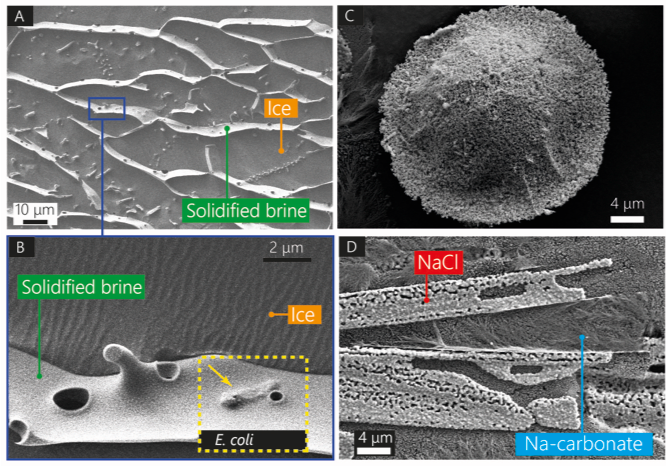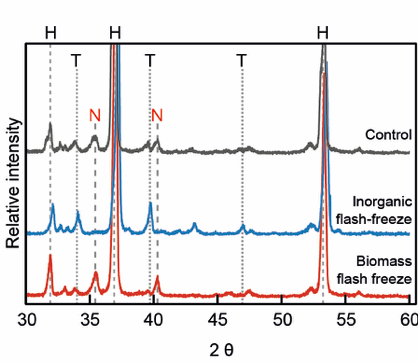Entombment of microbial biomass within rapidly frozen fluid droplets relevant to the plumes of Enceladus
- 1AstrobiologyOU, The Open University, Walton Hall, Milton Keynes, UK
- 2School of Earth and Environmental Sciences, University of St Andrews, St Andrews UK
Introduction. The plumes emanating from the south polar region of Saturn’s moon Enceladus were studied by the Cassini mission and have revealed evidence for ongoing hydrothermal activity [1], organic chemistry [2], and redox conditions favorable for microbial metabolism [3] in the ocean below. Salt-rich icy particles encountered by Cassini were interpreted to originate as rapidly frozen droplets of ocean spray [4]. If extant microbial communities exist within Enceladus’s ocean, cells may become incorporated into these particles and ejected into space where they can be sampled by future spacecraft [5]. However, the potential fate of biomass within frozen icy particles is not understood. Here, we used cryogenic imaging alongside sublimation-extraction techniques to study the interaction of microorganisms with precipitated inorganic phases during freezing of simulated Enceladus ocean fluids, at contrasting cooling rates. Our findings reveal how potential microbial biomass may be expressed in the Enceladus plumes, and carry implications for its potential detection using current and future spacecraft sampling strategies
Methods: Cells taken from four phylogenetically and morphologically distinct pure cultures, as well as a mixed community, were suspended in simulated Enceladus ocean fluid [6], and droplets were cooled at two contrasting rates: rapidly quench cooling in liquid nitrogen (101-102 K s-1), and gradual cooling (0.01 K s-1). Partitioning of microorganisms alongside ice and non-ice phases within frozen droplet interiors was imaged at 120 K via cryo-scanning electron microscopy. Specific associations between microorganisms and cryogenic mineral phases were analyzed using cryo-electron microscopy, and the mineralogy of crystalline precipitates was determined via infrared spectroscopy and X-ray diffraction (XRD) following extraction from the ice matrix by sublimation.
Results and discussion: Under both freezing scenarios, ice crystallisation produces an interconnected network of solidified solute-rich brine veins accumulated at ice grain boundaries, within which intact microorganisms can become entombed (Fig. 1). The presence of microbial cells also leads to the formation of small, solitary inclusions of brine fully encased by ice, which are disconnected from the main brine vein network. Microscale crystallization textures, previously identified to be diagnostic of cooling rate [6], are disrupted and modified by the presence of biomass, with distinct differences arising between brine veins and solitary inclusions. XRD analyses of cryogenic salt phases shows that the presence of microbial biomass during freezing also influences bulk mineralogy (Fig. 2). In the absence of biomass, nahcolite (NaHCO3) is kinetically inhibited during flash freezing. However, in the presence of biomass, nahcolite does form during flash freezing, and the resulting mineralogy instead resembles that of gradually cooled control fluids. This indicates that the presence of microorganisms kinetically favors the precipitation of nahcolite. Moreover, this finding provides a route by which the presence of biomass at Enceladus could influence the mineralogy of icy particles in the plumes. Given that mineralogy is also sensitive to cooling rate and fluid pH [6], analyses of mineralogy within plume particles at Enceladus should be prioritized in future observations.
Our results demonstrate how microbial biomass may be preserved within icy particles relevant to the Enceladus plumes, revealing complex, cooling rate-dependent interactions between microbial biomass and rapidly precipitating inorganic phases. The association of microbial cells with specific inorganic phases has implications for interpreting secondary ion fragments in spacecraft impact-ionization mass spectra [7], and in the planning for future plume sampling missions that target in situ analyses, or more ambitiously, cryogenic sample return.
References: [1] Waite, J. H. et al. Science 356, 155–159 (2017). [2] Postberg, F. et al. Nature 558, 564–568 (2018). [3] Ray, C. et al. Icarus 364, 114248 (2021). [4] Postberg et al. Science 459, 1098-1101 (2009). [5] Porco, C.C., et al. Astrobiology, 17, 876-901 (2017). [6] Fox-Powell & Cousins, JGR: Planets 126(1), e2020JE006628 (2021). [7] Klenner et al. Astrobiology 20, 1168-1184 (2020).

Figure 1. (Cryo) electron micrographs of co-partitioned cryogenic salt phases and microbial biomass. A, B., Cryo-SEM images of brine vein network with preserved E. coli cell. C., Solitary inclusion. D., brine vein crystallisation textures.

Figure 2. X-ray diffraction patterns from salt mineral assemblages produced by freezing in the presence and absence of microbial cells from community enrichments. ‘Control’ trace represents samples cooled gradually in the absence of biomass. H: halite (NaCl); T: Trona (Na2CO3•NaHCO3•2H2O); N: Nahcolite (NaHCO3).
How to cite: Fox-Powell, M., del Moral, Á., Stephens, B., Dazley, C., Slade, D., Richards, G., Cousins, C., and Olsson-Francis, K.: Entombment of microbial biomass within rapidly frozen fluid droplets relevant to the plumes of Enceladus, Europlanet Science Congress 2022, Granada, Spain, 18–23 Sep 2022, EPSC2022-1230, https://doi.org/10.5194/epsc2022-1230, 2022.

